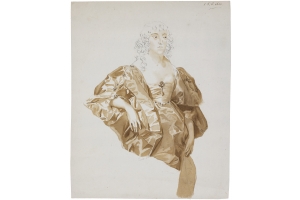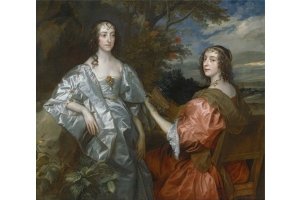

Jan de Bisschop was the son of Harmen Jansz. de Bisschop and Aaltje Adriaensz. van Noort. Jan preferred to call himself Episcopius as he had a strong preference for the latin language. He is assumed to have been an apprentice of Bartholomeus Breenbergh (Deventer, 1598-Amsterdam, 1657), though he was a dillettante. Jan studied Law in Leyden after which he settles as a lawyer in The Hague in 1652. He married Anna van Baerle (1615-1676) in 1653. In The Hague de Bisschop held close connections and friendship with the Huygens family, especially with Constantijn Huygens Jr (1628-1697).
Together with Jacob van der Does Sr., Maerten Lengele, Willem Doudijns and probably Constantijn Huygens Jr. as well, Jan de Bisschop founded a private drawing academy to promote Classicism.
De Bisschops most important publications on Claccisism would follow several years later with Signorum veterum Icones after classical sculptures in Rome and Paradigmata Graphices Variorum Artificium with etchings after drawings by Italian Masters. This second publication unfortunately unfinished due to de Bisschops premature death.[1][2]
Jan de Bisschop died of tuberculosis in 1671, after which his drawings and prints were auctioned. The copper plates for his etchings were purchased by Nicolaus Visscher who published a new edition of his graphics (Icones and Paradigmata).
Jan de Bisschop started copying after paintings by 16th and 17th century Masters around 1655. His goal was to recreate the original painting fully respecting the artists style and rendering, though translated into another medium with brush and ink on paper.
Actually, he was the very first to translate oil paintings into large size washed drawings. During the 16th century this manner of copying was applied but exclusively for copying sculptures and reliefs. His aim was to transfer the paintings as truthful as possible into drawings in black chalk and wash. These drawings often are sources of valuable information and sometimes the only remaining resources for paintings which got lost in the past. De Bisschops' copies were so highly esteemed, Arnold Houbraken even decided to mention and depict a portrait of Jan de Bisschop in his "Groote Schouburgh, 1721".
This drawing is part of a group of eight drawings, which were given to de Bisschop's intimate friend Constantijn Huygens Jr. (1628-1697) and were inherited by descent untill they appeared on the market recently. The drawings show de Bisschop at his very best and depict copies of paintings and sculptures after his most beloved artists alike Hans Holbein, Anthony van Dyck, Raphael, Titian, Tintoretto, Giulio Romano and de Ribera. Apart from few exceptions de Bisschop copied after the original works of art, which were part of famous collections such as the Royal House of Orange, Lady Arundel and Jan Six.
The present drawing appears to be a copy of part of Van Dyck’s portrait he painted c.1636-40 of Katherine, Lady Stanhope (1609-1667), later Countess of Chesterfield, with Lucy, Countess of Huntingdon (now in the Yale Center for British Art, New Haven), or perhaps after a version of the portrait with Lady Stanhope on her own (in a private collection).[3]
After the death of her first husband, Thomas 2nd Baron Wotton, Katherine Stanhope became the governess and confidante of Mary, Princess Royal and Princess of Orange after her second marriage with Philip Stanhope, 2nd Earl of Chesterfield (1634-1714). Asides from this she was the first woman to hold the office of Postmaster General of England.
A big and warm thank you to Catherine MacLeod, Senior Curator, Seventeenth-Century Portraits, National Portrait Gallery London for recognising the sitter.[4]
[1] Renske E. Jellema, Michiel Plomp, Episcopius / Jan de Bisschop; advocaat en tekenaar / lawyer and draughtsman. Waanders Uitgevers, Zwolle / Museum het Rembrandthuis, Amsterdam, 1992.
[2] Jan de Bisschop, Jan G. van Gelder, I. Jost, Jan de Bisschop and his Icones & Paradigmata. Classical Antiquities and Italian Drawings for Artistic Instruction in Seventeenth Century Holland. Davaco Publishers, Doornspijk, 1985.
[3] Susan Barnes, Nora de Poorter, Oliver Millar and Horst Vey, Van Dyck: a complete catalogue of the paintings. Yale University Press, 2004. Catalogue numbers IV.74 and IV.75.
[4] Correspondence by email, 2-1-2019